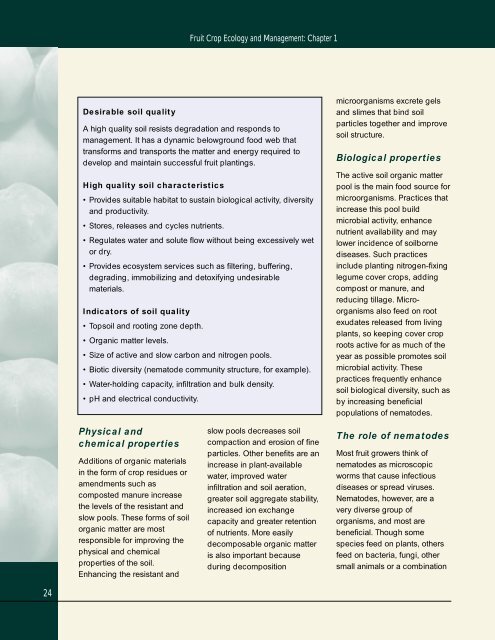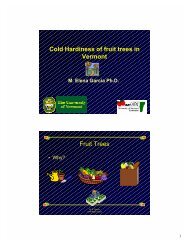Fruit Crop Ecology and Management - UVM Apple Orchard
Fruit Crop Ecology and Management - UVM Apple Orchard
Fruit Crop Ecology and Management - UVM Apple Orchard
You also want an ePaper? Increase the reach of your titles
YUMPU automatically turns print PDFs into web optimized ePapers that Google loves.
24<br />
Desirable soil quality<br />
Physical <strong>and</strong><br />
chemical properties<br />
Additions of organic materials<br />
in the form of crop residues or<br />
amendments such as<br />
composted manure increase<br />
the levels of the resistant <strong>and</strong><br />
slow pools. These forms of soil<br />
organic matter are most<br />
responsible for improving the<br />
physical <strong>and</strong> chemical<br />
properties of the soil.<br />
Enhancing the resistant <strong>and</strong><br />
<strong>Fruit</strong> <strong>Crop</strong> <strong>Ecology</strong> <strong>and</strong> <strong>Management</strong>: Chapter 1<br />
A high quality soil resists degradation <strong>and</strong> responds to<br />
management. It has a dynamic belowground food web that<br />
transforms <strong>and</strong> transports the matter <strong>and</strong> energy required to<br />
develop <strong>and</strong> maintain successful fruit plantings.<br />
High quality soil characteristics<br />
• Provides suitable habitat to sustain biological activity, diversity<br />
<strong>and</strong> productivity.<br />
• Stores, releases <strong>and</strong> cycles nutrients.<br />
• Regulates water <strong>and</strong> solute flow without being excessively wet<br />
or dry.<br />
• Provides ecosystem services such as filtering, buffering,<br />
degrading, immobilizing <strong>and</strong> detoxifying undesirable<br />
materials.<br />
Indicators of soil quality<br />
• Topsoil <strong>and</strong> rooting zone depth.<br />
• Organic matter levels.<br />
• Size of active <strong>and</strong> slow carbon <strong>and</strong> nitrogen pools.<br />
• Biotic diversity (nematode community structure, for example).<br />
• Water-holding capacity, infiltration <strong>and</strong> bulk density.<br />
• pH <strong>and</strong> electrical conductivity.<br />
slow pools decreases soil<br />
compaction <strong>and</strong> erosion of fine<br />
particles. Other benefits are an<br />
increase in plant-available<br />
water, improved water<br />
infiltration <strong>and</strong> soil aeration,<br />
greater soil aggregate stability,<br />
increased ion exchange<br />
capacity <strong>and</strong> greater retention<br />
of nutrients. More easily<br />
decomposable organic matter<br />
is also important because<br />
during decomposition<br />
microorganisms excrete gels<br />
<strong>and</strong> slimes that bind soil<br />
particles together <strong>and</strong> improve<br />
soil structure.<br />
Biological properties<br />
The active soil organic matter<br />
pool is the main food source for<br />
microorganisms. Practices that<br />
increase this pool build<br />
microbial activity, enhance<br />
nutrient availability <strong>and</strong> may<br />
lower incidence of soilborne<br />
diseases. Such practices<br />
include planting nitrogen-fixing<br />
legume cover crops, adding<br />
compost or manure, <strong>and</strong><br />
reducing tillage. Microorganisms<br />
also feed on root<br />
exudates released from living<br />
plants, so keeping cover crop<br />
roots active for as much of the<br />
year as possible promotes soil<br />
microbial activity. These<br />
practices frequently enhance<br />
soil biological diversity, such as<br />
by increasing beneficial<br />
populations of nematodes.<br />
The role of nematodes<br />
Most fruit growers think of<br />
nematodes as microscopic<br />
worms that cause infectious<br />
diseases or spread viruses.<br />
Nematodes, however, are a<br />
very diverse group of<br />
organisms, <strong>and</strong> most are<br />
beneficial. Though some<br />
species feed on plants, others<br />
feed on bacteria, fungi, other<br />
small animals or a combination



